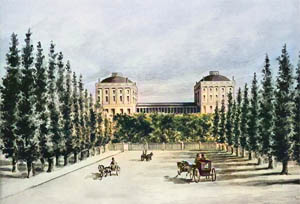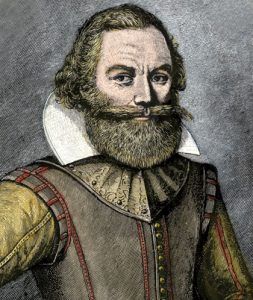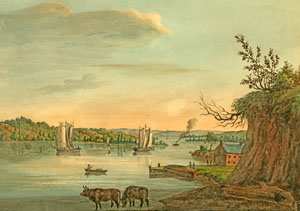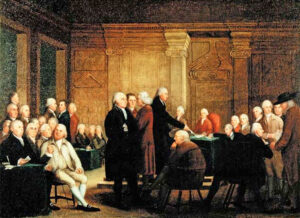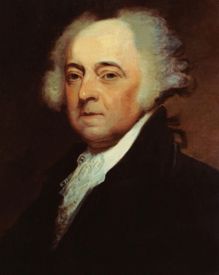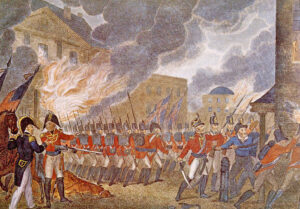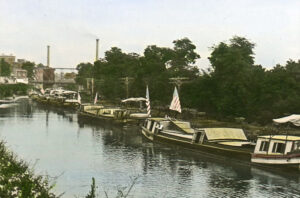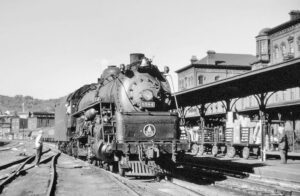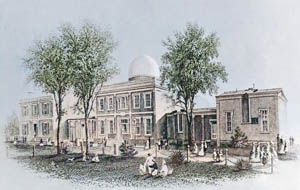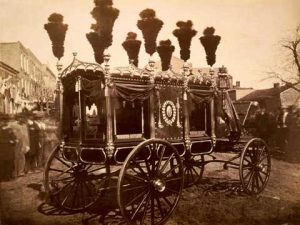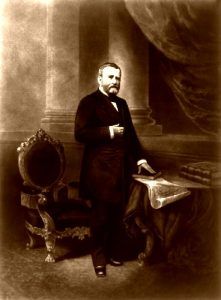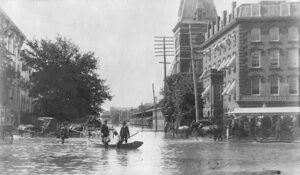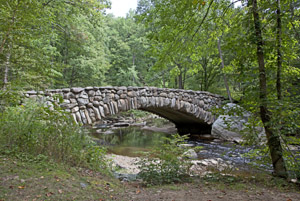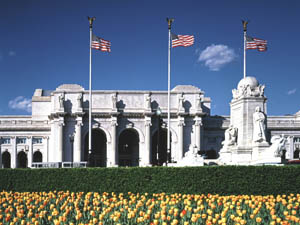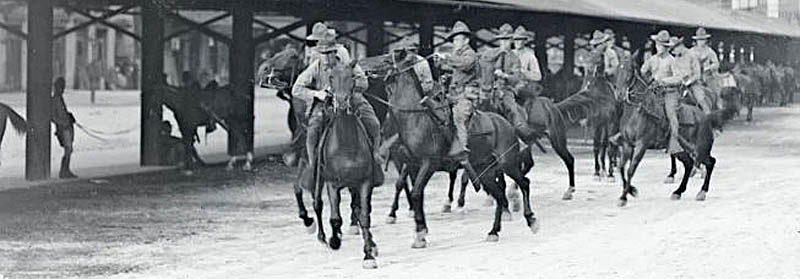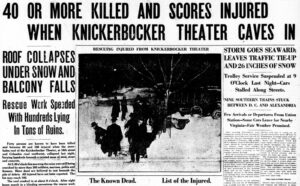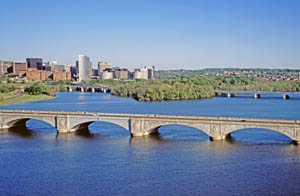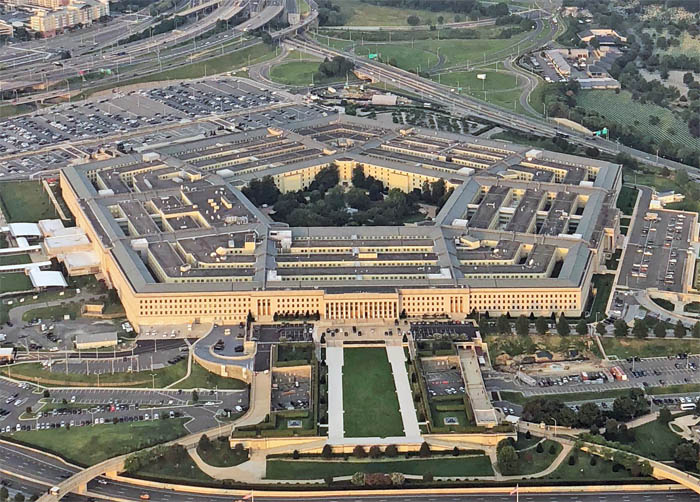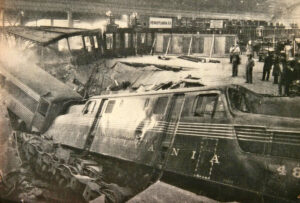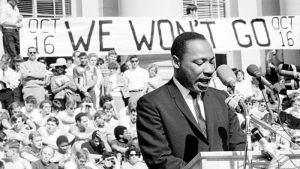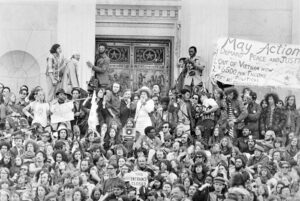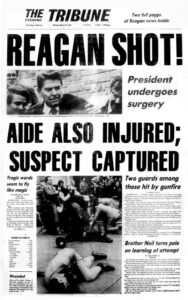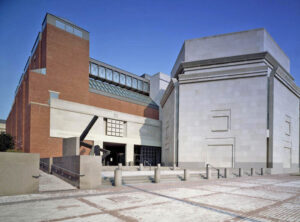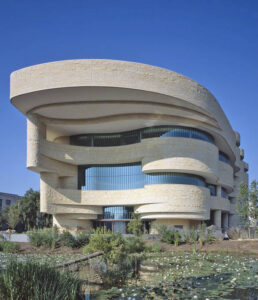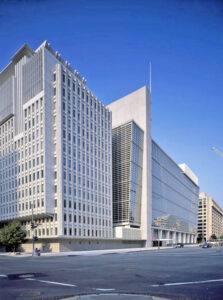Washington, D.C., formally called the District of Columbia, is the capital city and federal district of the United States. The United States Constitution provided for a federal district under the exclusive jurisdiction of the U.S. Congress.
It is located on the east bank of the Potomac River, which forms its southwestern border with Virginia and borders Maryland to its north and east. The city was named for George Washington, a Founding Father, commanding general of the Continental Army in the American Revolution, and the first President of the United States. The district is named for Columbia, the female personification of the nation that was commonly used at that time.
Archaeological evidence indicates American Indians settled around the Anacostia River at least 4,000 years ago.
Early European exploration of the region occurred early in the 17th century, including explorations by Captain John Smith in 1608.
At the time, the Patawomeck Indians, loosely affiliated with the Powhatan and the Doeg, lived on the Virginia side of the present-day city and Theodore Roosevelt Island. Various tribes of the Algonquian-speaking Piscatawa people, also known as the Conoy, resided on the Maryland side. Native inhabitants within present-day Washington, D.C., including the Nacotchtank, also called the Nacostine by Catholic missionaries, maintained settlements around the Anacostia River. Another village was located between Little Falls and Georgetown, and English fur trader Henry Fleet documented a Nacotchtank village called Tohoga on the site of present-day Georgetown.
The first colonial landowners were George Thompson and Thomas Gerrard, who were granted the Blue Plains tract in 1662, along with Saint Elizabeth and other tracts in Anacostia, Capitol Hill, and other areas down to the Potomac River in the following years. Thompson sold his Capitol Hill properties in 1670, including Duddington Manor, to Thomas Notley, while the Duddington property was handed down over the generations to Daniel Carroll of Duddington.
In 1697, the colonial-era Province of Maryland authorized the building of a fort within what is now Washington, D.C. As European settlers arrived, they clashed with the Native Americans over grazing rights. In 1697, the Piscataway relocated to the west, near what is now The Plains, Virginia, and in 1699, they moved again to Conoy Island near Point of Rocks, Maryland.
George Gordon constructed a tobacco inspection house along the Potomac River in about 1745. Alexandria, Virginia, was founded and incorporated on the West Bank of the Potomac River in 1749 as a site for tobacco transshipment.
Georgetown, the oldest neighborhood in the District of Columbia, was established in 1751 when the Maryland General Assembly purchased 60 acres of land for the town from George Gordon and George Beall for £280. A tobacco inspection warehouse was established. Originally a trading village called Tohoga by the local Native Americans, it was the farthest point upstream to which ocean-going boats could navigate the Potomac River. It was named for King George II of England.
The strong flow of the Potomac River kept a navigable channel clear year-round, and the daily tidal lift of the Chesapeake Bay raised the Potomac’s elevation in its lower reach to a point that fully laden ocean-going ships could navigate easily to the Bay. The first Georgetown survey was completed in February 1752. Warehouses, wharves, and other buildings were added, and Georgetown rapidly grew.
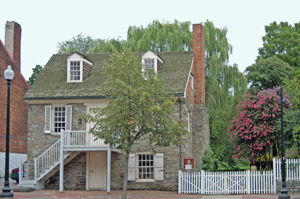
Old Stone House is in the Georgetown neighborhood of Washington, D.C., and is owned by the National Park Service.
The Old Stone House in Georgetown was built in 1765 and is the oldest standing building in Washington, D.C.. It did not take long before Georgetown grew into a thriving port, facilitating trade and shipments of tobacco and other goods from the colonial-era Province of Maryland.
On October 6, 1783, after the Pennsylvania Mutiny of 1783 forced the capital to relocate to Princeton, New Jersey, Congress resolved to consider a new location. The following day, it was moved “that buildings for the use of Congress be erected on the banks of the Delaware near Trenton, or of the Potomac River, near Georgetown, provided a suitable district can be procured on one of the rivers as aforesaid, for a federal town.”
In 1789, the town of Georgetown, Maryland, was chartered and incorporated. Georgetown’s economic and population growth also brought the founding of Georgetown University, which drew students from as far away as the West Indies. It was the country’s first Roman Catholic academic institution.
On July 17, 1790, Congress passed the Residence Act, creating a permanent federal government seat. George Washington, the country’s first president, carefully chose the site at the head of navigation on the Potomac River to accommodate ocean-going ships near the two well-established colonial port cities of Georgetown and Alexandria, Virginia. The site was between the Allegheny Mountains and the Atlantic Ocean. At that time, most of the land west of the Alleghenies was looked upon as a wilderness whose settlement was uncertain.
The initial shape of the federal district was a square, measuring ten miles on each side and totaling 100 square miles. Its location was centralized among the Eastern Seaboard states and was about 90 miles inland from the Atlantic Ocean. Built on a gently undulating, low, wide peninsula of land bounded by the Potomac River and its tributary, the Anacostia River, it was believed the location would develop into an important commercial port in and of itself. That year, French-born American engineer and designer Pierre Charles L’Enfant was chosen to plan the new capital city.
Bridging the Northern and Southern states, Washington called it “the gateway to the interior” because he hoped it would also serve to economically bind the Western territories to the Eastern Seaboard and secure the allegiance of the frontier to the new country.
In 1791-92, a team led by Andrew Ellicott, including Ellicott’s brothers Joseph and Benjamin Banneker, a self-educated free African American man and astronomer, surveyed the 100-square-mile territory, established the borders of the federal district and placed 40 sandstone boundary markers at every mile point; 36 of which still stand today. The territory surveyed by Ellicott was ceded by Maryland, a slave state, and Virginia, the Southern state with the largest slave population, thus contributing to a significant Black presence in Washington.
The Tudor Place residence was built in Georgetown in 1794. From 1805 to 1983, it was home to six generations of Martha Washington’s descendants. Today, it serves as a museum.
In 1797, the Bridge at Little Falls” crossing the upper Potomac River several miles northwest of Georgetown, opened at the future site of the 19th-century Chain Bridge.
The Washington Navy Yard, established in 1799 on the Anacostia River, was essential in developing the southeastern section of Capitol Hill. Its purpose was the defense of the capital and the construction of warships. It served as the principal employer in Washington for 150 years, providing job opportunities mainly to skilled African Americans and European immigrants. Many of these early laborers, who walked to work at the yard, built their own small, two-story brick and wooden row houses nearby. In the 20th century, the Navy Yard became one of the world’s largest ordnance production and engineering research centers.
Before establishing Washington, D.C., as the nation’s capital in 1800, the Second Continental Congress was based in Philadelphia, Pennsylvania, on five separate occasions between May 1775 and June 1783. Government business was also held briefly in five other locations, including York, Pennsylvania, in September 1777; Princeton, New Jersey, in 1783; Annapolis, Maryland, from November 1783 to August 1784; Trenton, New Jersey, in November and December 1784, and New York City from January 1785 to March 1789.
From May 14 to November 1, the seat of the Federal government of the United States relocated after ten years from the second federal capital of Philadelphia, Pennsylvania, to a constitutionally designated ten-mile square federal district on both sides of the Potomac River entitled District of Columbia. Originally called the “Federal City,” it soon acquired its namesake after President George Washington, known in the 19th century as Washington City.
The United States Capitol building construction continued with partially completing the north Senate wing, where the United States Congress met for its first sessions in Washington. Construction continued on the House of Representatives’ south wing. The Senate wing was completed first, temporarily providing spaces to be used by both houses of Congress, the beginnings of the Library of Congress and the Supreme Court for several years of continued construction work.
In 1800, the population of the District of Columbia was 14,093, comprised of 10,066 whites, 783 free Blacks, and 3,244 enslaved persons. At that time, one community consisted of primarily affluent descendants of Europeans who held various religious beliefs and political views but generally shared an optimism in the potential for self-government and a desire to participate. Another early community was made up of laborers — some educated or skilled, others uneducated or unskilled — who physically built the country’s capital; most of these laborers were free Blacks, slaves, and immigrants. Because Washington boasted no major industries, these early immigrants were mainly skilled workers and entrepreneurs from Scotland and Ireland. By the mid-to-late 19th century, additional immigrants from Germany, Italy, eastern Europe, Greece, and China had established ethnic enclaves within Washington.
Second President John Adams was the first chief executive to occupy the White House with his wife Abigail in the unfinished mansion. The Adams occupied the house for only the last four months of his term, having been defeated for reelection by incumbent Vice President Thomas Jefferson in the Election of 1800.
Construction of the Capitol, the White House, and several other government buildings was almost complete when Congress moved from Philadelphia to Washington in December 1800. However, few finished dwellings and even fewer amenities existed in Washington at the time, making the first several years rather unpleasant for the new residents.
Congress passed the District of Columbia Organic Act on February 24, 1801, which officially organized the district and placed the entire territory under the federal government’s exclusive control. After the Act’s passage, citizens in the district were no longer considered residents of Maryland or Virginia, which ended their representation in Congress. U.S. President Thomas Jefferson was inaugurated on March 4, 1801. That year, the first July 4th celebration was in Washington.
In 1802, Congress granted the City of Washington a city charter and incorporated it. A mayor-council government was established, with the first mayor appointed by the President.
In 1805, the first Inaugural parade occurred, and Lafayette Square was designated a public park by President Thomas Jefferson Jefferson.
In 1806, a public school opened in the city.
Rows of poplar trees were planted along Pennsylvania Avenue in 1807.
On May 20, 1809, the Long Bridge crossing the Potomac River near 14th Street S.W. opened.
In 1810, the District of Columbia’s population was 24,023, comprised of 16,093 whites, 2,549 free Blacks, and 5,381 enslaved people.
In 1812, the United States declared war against Great Britain. During the War of 1812, British forces invaded and raided Washington, D.C., in what is known as the Burning of Washington. The U.S. Capitol, the Department of the Treasury, and the White House were burned and gutted in the attack. Structural damage was extensive, and the morale of the local citizens sank. Most government buildings were repaired quickly; however, the Capitol was largely under construction at the time and was not completed in its current form until 1868.
The Washington City Canal began operating in 1815. St. John’s Episcopal Church was built in Lafayette Square the following year.
By 1817, a newly reconstructed White House welcomed President James Monroe. Congress reconvened in the newly built Capitol in 1819 after spending five years in the temporary Old Brick Capitol Building, which had been erected on the present-day Supreme Court Building site.
In 1818, a central heating system was installed in the U.S. Capitol building.
The District of Columbia’s population was 33,039 in 1820, comprised of 22,614 whites, 4,048 free Blacks, and 6,377 enslaved people.
In 1821, the Washington City Council enacted codes requiring free Black people to show the Mayor of Washington City evidence of their freedom with certificates from three residents vouching for their character.
In 1827, Washington City Council intensified Black Codes, stipulating that free Blacks caught without certificates of freedom would be placed in jail and sold into slavery if unclaimed.
Beginning in 1828, the construction of the Chesapeake and Ohio Canal brought new jobs to the old port city. Mills, foundries, and lime kilns began to line Georgetown’s waterfront. Its ethnically and economically diverse population consisted mainly of merchants, laborers, and government employees. Canal Construction continued until 1850.
The District of Columbia’s population was 43,700 in 1830, comprised of 27,635 whites, 6,163 free Blacks, and 6,000 enslaved persons.
In the 1830s, the district’s southern territory of Alexandria declined economically due in part to its neglect by Congress. Alexandria was a significant market in the domestic slave trade, and pro-slavery residents feared that abolitionists in Congress would end slavery in the district, further depressing the local economy. Alexandria’s citizens petitioned Virginia to take back the land it had donated to form the district through a process known as retrocession.
Between 1830 and 1865, tremendous changes occurred in Washington, beginning with the arrival of President Andrew Jackson, who brought with him a retinue of new civil servants who introduced democratizing social changes to the workplace and the community. Challenges were plentiful — the local economy was unstable; silt in the Potomac River restricted navigation; the Chesapeake and Ohio Canal construction was delayed; and epidemics were common.
In 1835, the Baltimore and Ohio Railroad began operating. The same year, a labor strike by Federal Navy Yard workers occurred, and several mob actions aimed at Black residents and abolitionists prompted the City Council to enact restrictions on licenses issued to free Black vendors.
After the railroad arrived, a flood of tourists came with it, as did a proliferation of congressional spouses, who forever changed Washington’s social scene. Major construction projects for three federal buildings located blocks apart in Downtown Washington included the Department of the Treasury, the General Post Office, and the Patent Office.
In 1836, the city was flooded with petitions advocating for the end of slavery in the District of Columbia, and Congress enacted a gag rule banning petitions related to slavery. On December 15, 1836, the U.S. Patent Office was burned down by fire. It occurred in Blodget’s Hotel building. An initial investigation considered the possibility of arson due to suspected corruption in the Post Office, which shared the same building, but it was later ruled out.
In 1840, the population of the District of Columbia was 43,700, comprised of 30,655 whites, 8,361 free Blacks, and 4,684 enslaved persons.
In 1841, the first statue of George Washington was a white marble Romanesque rendering of the first president. The completed 12-ton marble statue atop a granite pedestal and base depicted the first president wearing a chest-baring toga. While many viewers appreciated the artist’s attempt to create a timeless masterpiece, others saw only an inappropriately dressed Washington. It was exhibited outside in the Capitol Rotunda from 1841 to 1843 when it was relocated to the east lawn. In 1908, Congress transferred the statue to the Smithsonian Institution, where it was exhibited in the Smithsonian Castle until its relocation to the new National Museum of American History in 1964.
In 1842, the United States Naval Observatory was established.
The Baltimore-Washington telegraph began operating in 1844.
The Virginia General Assembly voted in February 1846 to accept the return of Alexandria. On July 9, 1846, Congress agreed to return all territory that Virginia had ceded to the district during its formation. This decision left the district’s area consisting only of the donated portion by Maryland. That year, the National Smithsonian Institution was established.
In 1848, the cornerstone of the Washington Monument was placed, and the Washington Gas Light Company was established. That year, 77 enslaved people from Washington City and Georgetown attempted to escape slavery on the schooner Pearl. Supporters of slavery were outraged by the attempted escape, and an angry mob formed. For three days, crowds were riled in the Washington Riot, and numerous police were called in to protect one of their targets. After their capture, all 77 slaves were given to slave traders from Georgia and Louisiana, who would take them to the Deep South and the New Orleans slave market. That year, gaslights were installed along Pennsylvania Avenue.
In 1850, Congress prohibited the importation of enslaved people for the purpose of sale in the District of Columbia and outlawed the slave trade in the district, although not slavery itself. At that time, the population of the District of Columbia was 51,687, comprised of 37,941 whites, 10,059 free Blacks, and 3,687 enslaved persons. This was the first census count that did not include Alexandria and Alexandria County.
The University of the District of Columbia was founded in 1851. It was formerly known as Miner Normal School,
In 1854, the railroad arrived, and construction of a terminal began on The Mall.
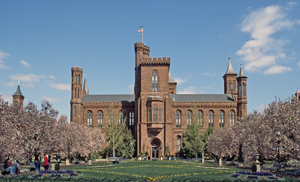
Springtime view of the Smithsonian Institution “Castle,” the museum complex’s first building when it was simply called the “National Museum.”
The Smithsonian Institution Building, known as the Castle, was completed in 1855. The same year, the Armory was built on The Mall
On June 1, 1857, a Know-Nothing associated gang, the Plug Uglies, traveled to Washington. D.C.. from Baltimore, in an attempt to prevent German and Irish immigrants from voting in the local election. The group allied with like-minded groups and moved to Mount Vernon Square to harass anti-Know Nothing voters. With pistols, clubs, bricks, and other weapons, they charged into the crowd of voters. A brutal fight broke out, which the police were unable to stop, and by noon, President Buchanan had called out two companies of Marines to stop the riot. Eight people were killed by the end of the day, and at least 15 were injured.
In 1860, an equestrian statue of George Washington was placed in Washington Circle, northwest of the White House. At that time, the city’s population had grown to 61,122.
The outbreak of the Civil War in 1861 led to the expansion of the federal government and notable growth in the district’s population, including a large influx of freed slaves. The city was never far from the front lines during the Civil War due to the Confederate capital in Richmond, Virginia, close proximity.
President Abraham Lincoln signed the Compensated Emancipation Act in 1862, which ended slavery in the district, freeing about 3,100 slaves in the district nine months before the Emancipation Proclamation. The bill also provided compensation for loss of property to owners loyal to the Union. At that time, Congress required the city to provide schooling for black students.
In 1863, the National Academy of Sciences was headquartered in the city. That year a prominent memorial was dedicated in 1863, though it had been planned years earlier, namely the Statue of Freedom on top of the Capitol. The majority of Washington’s circles and squares were renamed for and display statues of Civil War heroes, including Admiral David Farragut and Generals Ulysses S. Grant, Winfield Scott Hancock, John A. Logan, George B. McClellan, James B. McPherson, George G. Meade, John A. Rawlins, Winfield Scott, Philip H. Sheridan, William Tecumseh Sherman, and George H. Thomas.
The Battle of Fort Stevens occurred during the Valley Campaigns in July 1864. After the Union victory, the Confederates headed to Leesburg, Virginia.
After the Civil War, Washington expanded beyond its planned boundaries and became legally indistinguishable from the District of Columbia. This period brought an influx of middle-class government workers to Capitol Hill, and with them came developers who built row after row of two- and three-story attached brick homes. The first black school opened at 2nd and C, S.E. Streets.
After the assassination of President Abraham Lincoln at Ford’s Theatre on April 15, 1865, just days after the war’s end, Washington was plunged into unprecedented desperation and despair. Two outdoor statues were quickly erected to honor the slain president. The first stands in front of the old City Hall in downtown Washington, and the second, on Capitol Hill in Lincoln Park, was paid for by donations solely from former slaves.
In 1868, Congress granted the district’s African American male residents the right to vote in municipal elections.
The National Convention of the Colored Men of America and the American Equal Rights Association were held in the city in 1869.
By 1870, the district’s population had grown 75% from the previous census to nearly 132,000 residents. However, despite the city’s growth, Washington still had dirt roads and lacked basic sanitation. Some members of Congress suggested moving the capital farther west, but President Ulysses S. Grant refused to consider the proposal. Children’s Hospital was established in 1870. That year, the city’s population was 109,199.
Congress passed the Organic Act of 1871, which repealed the individual charters of the cities of Washington and Georgetown, abolished Washington County, and created a new territorial government for the whole District of Columbia. At that time, the citizens of the District lost representation in their local government, and the U.S. president appointed a governor and an 11-member council for four-year terms. For a time, newspapers referred to the Georgetown port as West Washington, but ultimately, the old name prevailed.
Under the new territorial government, which lasted just three years, numerous city improvement projects were undertaken, including erecting modern schools and markets, streets paved, installing outdoor lighting and sewers, and planting more than 50,000 trees. However, the price for these improvements was far more than Congress had anticipated. The new territorial government was short-lived, but Congress was required to complete the projects.
In 1872, the District territorial government passed a civil rights bill that barred racial discrimination in most places.
In 1873, President Grant appointed Alexander Robey Shepherd as Governor of the District of Columbia. Shepherd authorized large-scale projects that significantly modernized the city but bankrupted the district government.
In 1874, Congress replaced the territorial government with an appointed three-member board of commissioners.
Congress passed a Civil Rights Act that provided equal accommodation for Black people in public places and on public transport in 1875.
The Washington Post newspaper began publication in 1877. At the end of Reconstruction in 1877, the city’s African American population had more than doubled in the time from the start of the Civil War in 1861, when tens of thousands of freed Blacks began to pour into the city.
In 1878, the telephone began operating in the city.
In 1880, the population of the District of Columbia was 177,624, comprised of 118,006 whites, 59,596 Blacks, and 22 other non-whites.
In the 1880s, several newcomers arrived in Washington from nationwide. Many of them were affluent intellectuals and lobbyists. This new “elite” made Washington their part-time home during the winter social season. Members of the old Washington society became known as “Cave Dwellers,” a local term for descendants of the original families of the area. They generally still keep within their own social circles.
In February 1881, melting snow caused the Potomac River to flood sections of the National Mall, nearly up to the Capitol building. It was so severe that people couldn’t access the southern part of the city except by boat. Parts of the river and flats were filled to prevent another major flood. Tiber Canal was filled in and became Constitution Avenue. The same year, the American National Red Cross was headquartered in the city.
In 1882, Congress allocated money to dredge the Anacostia River to create the Washington Channel and East and West Potomac Parks.
In 1885, the Washington Monument, a 555-foot unadorned obelisk, was dedicated on the Mall.
In 1888, the city’s first motorized streetcars began service. Their introduction generated growth in areas beyond the city’s original boundaries, leading to its expansion over the next few decades.
Rock Creek Park was established in 1890. At that time, the city had more than 100 miles of tramway. The District of Columbia population was 230,392, comprising 154,695 whites, 75,572 Blacks, and 125 non-whites.
In 1891, Georgetown was included in the parcel of land transferred by Maryland to become part of the District of Columbia.
In 1893, American University was founded.
In 1894, Coxey’s Army marched on Washington, D.C. It was a protest march by unemployed workers led by Ohio businessman Jacob Coxey. It was the second year of a four-year economic depression that was the worst in United States history at the time.
Georgetown’s street grid and other administrative details were formally merged with those of the City of Washington in 1895. However, the city had poor housing conditions, which strained public works. In the early 20th century, Georgetown became the first city in the nation to undergo urban renewal projects as part of the City Beautiful movement.
In 1897, the American Negro Academy was founded.
Height restrictions for buildings in Washington were enacted by Congress as early as 1899 because of concerns over tall buildings’ fire safety and aesthetics.
Encircling the city is a series of terraces that, in certain areas, rise to about 400 feet above sea level, where Washington’s neighborhoods were gradually built. Part of a shallow, long ravine — what is now Rock Creek Park — separated Washington from the old port city of Georgetown; development to the north and west of this ravine was slow until the end of the 19th century when the ravine was bridged, and public transportation was made available.
Washington’s streets were organized in a scheme of broad diagonal avenues overlain on a grid of wide north-south- and east-west-trending streets. Thus, an orderly web of wide tree-lined avenues creates grand vistas and leads to powerful focal points and open public spaces. The intersections of two or three diagonal avenues are punctuated with landscaped circles and squares. In contrast, their intersections with grid streets create triangular and trapezoidal lots and parks, resulting in interesting streetscapes.
During the last half of the 20th century, the “suburban flight” of the middle class contributed to the city’s loss of more than one-fourth of its population. As new jobs, especially those in the high-technology industries, were created in Maryland and Virginia, the population of the suburbs increased as much as 50% per decade.
By the end of the 19th century, Georgetown was no longer considered a fashionable place to live. Only a few wealthy residents remained in their dignified old mansions, next to brick and wooden row houses occupied by lower and middle-class laborers.

Port of Georgetown
In 1900, the city’s population was 278,718. At that time, Washington had the largest urban African American population in the United States, and several prominent Black leaders and educators lived there.
In 1901, the Senate Park Commission offered comprehensive and resolute recommendations for revitalizing and beautifying Washington. The new plans were stunning, but years would pass before they could be realized.
By the first decade of the 21st century, Washington’s population increased as younger workers moved into revitalized city neighborhoods. Despite these population shifts, the District’s and nearby Maryland and Virginia’s economies remain interdependent.
In 1906, the District Building (city hall) was constructed. Union Station was built the following year, and construction began on the Washington National Cathedral.
Union Station was constructed, and the old railroad terminal on the Mall was removed in 1908.
The Height of Buildings Act of 1910 assured the city’s horizontal landscape. According to the act, no building in Washington can be taller than 130 feet, though certain structures can extend an additional 30 feet along certain portions of Pennsylvania Avenue. Office buildings could be no wider than the street on which they are built, plus 20 feet and most are about 120 feet wide. Thus, Washington, D.C. lacks the characteristic skyscrapers of other large U.S. cities. At that time, Washington’s population was 331,069.
In 1912, cherry trees were planted around the Tidal Basin.
The United States declared war on the German Empire on April 6, 1917, nearly three years after World War I started. President Woodrow Wilson gave Washington a voice in world affairs through the country’s entry into World War I and through his work establishing the League of Nations, an organization promoting international cooperation. Before entering the war, the U.S. had remained neutral, though it had been an essential supplier to the United Kingdom, France, and the other powers of the Allies of World War I. Despite the war, the National Sylvan Theater opened in 1917.
After German morale collapsed at home and on the battlefield, the Allies achieved victory over the German Empire when a ceasefire and truce were declared on November 11, 1918. After the war, civic pride and culture flooded Washington, D.C.. Art galleries, museums, concert halls, and the Lincoln Memorial were built. The Commission of Fine Arts was established to advise city planners on the appropriate design and placement of memorials and federal buildings. At the same time, however, run-down buildings were multiplying in Washington’s back alleys.
1919 – Beginning on July 19, Washington, D.C., had four days of mob violence against black individuals and businesses perpetrated by white men. The violence was during the civil unrest of what became known as Red Summer, a pattern of white-on-black violence that occurred in more than three dozen cities across the United States. Fifty people were seriously wounded, and another 100 less severely wounded.
By the 1920s, many residences and churches had nearly filled the Capitol Hill neighborhood. Within a few decades, the neighborhood was densely settled within a five-block area northeast and southeast of the Capitol. The community remained stable until World War II when many row houses were converted into rooming houses and rental properties.
In 1920, the 16th Street World War I Memorial Trees were dedicated. That year, the city was called home to 437,571 people.
On January 28, 1922, a snowstorm crushed the Knickerbocker Theatre, killing 98 people and injuring 133. A few months later, on May 30, the Lincoln Memorial was dedicated. More than two feet of freshly fallen snow seriously stressed the theater’s flat roof. It would collapse,
In 1924, the National Capital Park Commission was established. The Washington Senators baseball team won the 1924 World Series the same year.
WMAL radio began broadcasting in 1925.
Federal Triangle construction began in 1926. That year, in Corrigan v. Buckley, the D.C. Court of Appeals cited the widespread use of segregation laws in the District of Columbia to uphold the constitutionality of restrictive covenants that prevented property sale to individuals based on race and ethnicity. The U.S. Supreme Court declined the case.
Washington’s population in 1930 was 486,869.
In the 1930s, increased federal spending due to President Franklin Delano Roosevelt’s New Deal program led to the district’s construction of new government buildings, memorials, and museums. Thousands of workers were employed in Washington, not only in existing government offices but also in constructing new federal buildings, including the Supreme Court and the Federal Triangle buildings. Many poor rural African Americans moved from the South to settle in Washington during that time. However, neglected neighborhoods only worsened during these years.
In 1932, the Arlington Memorial Bridge opened, and the Folger Shakespeare Library was built.
The National Park Service took control of the federal reservations in 1933.
The National Cherry Blossom Festival began in 1935.
In 1937, the Washington Redskins football team was active.
The Jefferson Memorial was completed in 1938.
Washington’s population was 663,091in 190.
In 1941, the National Airport was built, and the National Gallery of Art opened.
In 1932, the Pentagon was completed, establishing the capital city as the country’s military command center.
World War II led to the city’s expansion of federal employees, and the Capitol Hill neighborhood’s population swelled with workers. Washington’s population surged to about 950,000 during World War II (1939–45).
In 1946, the International Monetary Fund was headquartered in the city. WMAL-TV, WRC-TV, and WTTG television stations began broadcasting the following year.
In 1948, the Supreme Court ruled in Hurd v. Hodge that restrictive housing covenants were not legally enforceable. Racially restrictive covenants were widespread throughout the District of Columbia.
In 1949, the Whitehurst Freeway began operating, and the WTOP-TV station began broadcasting. The same year, Mary Church Terrell and other civil rights activists established the Coordinating Committee for the Enforcement of the Civil Rights Acts of 1872 and 1873, prohibiting discrimination against Blacks in public places.
By 1950, the district’s population reached its peak of 802,178 residents. The following year, Congress designated most of Georgetown as a historic district.
The first half of the 20th century was an explosive time in the capital city — socially, economically, and culturally — and Washington began to gain worldwide attention. Grand homes for embassies were constructed on 16th Street, north of the White House, and later along Massachusetts Avenue, a strip now known as Embassy Row.
During the second half of the 20th century, Washington experienced an exodus of the European American and African American middle class as they fled to the developing suburbs of nearby Maryland and Virginia. Nonetheless, Washington continued to develop into a modern city, becoming unrecognizable to those who had known it before World War II. Many former Washington neighborhoods were ravaged, and in their place, huge, impersonal federal agency buildings were constructed. Public housing complexes were erected in poorer areas of the city for those who could not afford to move elsewhere. Modern highway plans for Washington were bitterly opposed by both Black and white communities across the city. Still, they only partially successfully prevented highway expansion through the older neighborhoods.
The neglected beauty of the city was finally recognized, and with the aid of President John F. Kennedy and First Lady Jacqueline Kennedy, an interest in historical preservation ensued. However, Vietnam War protests and race riots in Washington throughout the 1960s deterred people from moving into the city. The construction of a subway system, designed by Harry M. Weese, beginning in the late 1970s, made the city more accessible and awakened a renewed interest in various parts of Washington. The real-estate boom of the 1980s began revitalizing many of the city’s deteriorating areas.
In the 1950s, the African American and European American middle class flocked to the suburbs, converting many Capitol Hill homes into boarding houses for displaced low-income residents, most of whom were African American. Public housing facilities were also built in certain sections of the neighborhood. By the end of the decade, the area was called “blighted and obsolete” by the media and members of Congress.
On January 15, 1953, a Pennsylvania Railroad train wreck occurred when a passenger and mail train from Boston to Washington, D.C., failed to brake sufficiently on its approach to Union Station, Washington, jumping the platform and plunging through the concourse floor. No deaths were reported, but 43 people were injured. The cause of the accident was a design flaw that allowed an air brake valve to close without human intervention.
That year, the Supreme Court decided the Thompson Restaurant case, stating that restaurants in the District of Columbia could not refuse service to “well-behaved and respectable” Black people. This decision reinforced the District Civil Rights Acts of 1872 and 1873, referred to as the lost laws because they were omitted from the D.C. Law Code of 1901.
On March 1, 1954, a shooting attack was made on the United States Capitol by four Puerto Rican nationalists who sought to promote the cause of Puerto Rico’s independence from U.S. rule. They fired 30 rounds from semi-automatic pistols onto the legislative floor from the Ladies’ Gallery (a balcony for visitors) of the House of Representatives chamber. Five Representatives were wounded, one seriously, but all recovered. The assailants were arrested, tried, and convicted, with all receiving long consecutive prison sentences. In 1978 and 1979, their sentences were commuted by President Jimmy Carter, and all four returned to Puerto Rico.
The same year, the D.C. Recreation Board ended segregated playgrounds in the District of Columbia. The Supreme Court ruled in Brown v. Board of Education of Topeka, Kansas, that separate but equal educational facilities were “inherently unequal,” mandating an end to segregated public schools. Washington’s schools were integrated in the 1954-55 school year.
In 1960, Washington’s population was 763,956.
The 1961 ratification of the 23rd Amendment allowed District residents to vote in Presidential elections. Before that time, the District of Columbia residents had been denied the right to vote in presidential elections.
Streetcars stopped operating in 1962.
On August 28, 1963, the March on Washington for Jobs and Freedom took place, and Martin Luther King Jr. gave his “I Have a Dream” speech.
Washington, D.C., residents could vote for president for the first time in November 1964. The passage of the 23rd Amendment in 1961 gave citizens of the nation’s capital the right to vote for a commander-in-chief and vice president. The same year, the Capital Beltway was constructed.
On April 17, 1965, the March Against the Vietnam War occurred. It was the largest anti-war protest held in Washington, D.C., up to that time. With 15,000–25,000 marchers, it was close to the number of U.S. soldiers in Vietnam then. That year, the Washingtonian magazine began publication, and Pennsylvania Avenue was designated a national historic site.
The Smithsonian Folklife Festival began in 1967, and the Biograph Cinema opened.
Following the assassination of Martin Luther King Jr., a leading African American civil rights activist, on April 4, 1968, Washington, D.C., experienced four days of violent civil unrest and rioting. It was part of the broader riots that affected at least 110 U.S. cities. Those in Washington, D.C., Chicago, and Baltimore were among those with the most significant numbers of participants. President Lyndon B. Johnson called the National Guard to the city on April 5, 1968, to assist the police department in quelling the unrest. Ultimately, 13 people were killed, with approximately 1,000 people injured and over 6,100 arrested.
American Association of Retired Persons headquartered in the city in 1868. That year, subway construction began.
In 1969, the Gay Blade newspaper began publication, and the Key Theatre opened.
In 1970, the city’s population was 756,510. By the 1970s, nearly three-fourths of the capital city’s population was African American. Although this proportion shrank over the next few decades, African Americans continued to constitute the majority of D.C.’s population into the early 2000s.
In 1971, more Antiwar protests occurred, and on June 30, the New York Times Co. v. United States decided to allow the Washington Post to publish the Pentagon Papers about Vietnam. That year, the
National Kennedy Center for the Performing Arts opened, and the Center for Science in the Public Interest was headquartered in the city.
The Watergate scandal discovered was discovered in 1972. The major political scandal involving the administration of President Richard Nixon from 1972 to 1974 led to Nixon’s resignation. The scandal stemmed from the Nixon administration’s attempts to cover up its involvement in the June 17, 1972, break-in of the Democratic National Committee headquarters in Washington, D.C., at the Watergate Office Building.
On February 17, 1974, United States Army Private Robert Kenneth Preston took off in a stolen Bell UH-1B Iroquois helicopter from Tipton Field, Maryland. He landed it on the South Lawn of the White House in a significant security breach. Preston had enlisted in the Army to become a helicopter pilot. However, he did not graduate from the helicopter training course and lost the opportunity to attain the rank of warrant officer pilot. Instead, he was sent to Fort Meade as a helicopter mechanic. Preston believed this situation was unfair and later said he stole the helicopter to show his skill as a pilot. Preston pleaded guilty to “wrongful appropriation and breach of the peace” in a plea bargain and was sentenced to one year in prison and a fine of $2,400.
In 1976, the Washington Metro began operating, the U.S. Bicentennial was held, and C-SPAN began televising federal government proceedings. The subway and Constitution Gardens opened.
On March 30, 1981, an attempted assassination was made on President Ronald Reagan. The president was shot and wounded by John Hinckley Jr. in Washington, D.C., as he was returning to his limousine after a speaking engagement at the Washington Hilton. Hinckley believed the attack would impress actress Jodie Foster, with whom he had developed an obsession. That year, the Washington City Paper began publication.
January 13, 1982, as Air Florida Flight 90 was flying from Washington National Airport to Fort Lauderdale–Hollywood International Airport, the Boeing 737-222 crashed into the 14th Street Bridge over the Potomac River just after takeoff. Striking a bridge between Washington, DC, and Arlington County, Virginia, it hit seven occupied vehicles and destroyed 97 feet of guard rail before plunging through the ice into the Potomac River. Of the 74 passengers and five crew members aboard, only five survived the crash. Four motorists on the bridge were also killed.
The same year, the Washington Convention Center was built, the National Vietnam Veterans Memorial was erected, and the Washington Times newspaper began publication.
On November 7, 1983, during an evening session, a bomb exploded on the second floor of the Capitol’s north wing; adjacent hallways were mainly unoccupied at the time. There were no casualties.
In 1985, the Federal News Service began business, and the National Building Museum opened.
The death of University of Maryland basketball star Len Bias in 1986 due to a cocaine overdose brought Congressional attention to the crack cocaine epidemic and associated murder rate in Washington, D.C.
The population of the city was 606,900 in 1990.
Creating Washington, D.C., as the 51st state, was popular in the 1990s. It is still supported by some residents who object to being taxed by the federal government while lacking proper representation in Congress. Statehood would give the District the power to levy its own taxes and remove development restrictions. Still, it also would mean the loss of the annual federal payment, totaling hundreds of millions of dollars, made to the city. In any case, Congress lacks the authority to grant statehood without a constitutional amendment ratified by 36 states.
In 1993, the United States Holocaust Memorial Museum and National Postal Museum opened.
The Franklin Delano Roosevelt Memorial opened in 1997.
On July 24, 1998, a shooting at the United States Capitol occurred when Russell Eugene Weston Jr. entered the Capitol and two Capitol Police officers. He had expressed strong distrust of the federal government. Three others were injured, including the perpetrator.
By the end of the 20th century, several historic Georgetown homes had been opened to the public, including the Old Stone House, Tudor Place, Dumbarton House, and Dumbarton Oaks Estate and Gardens. In the early 21st century, Georgetown residents included university students, government and private sector workers, and upper-middle-class families. The neighborhood has a variety of unique shops, restaurants, and nightclubs.
Within two centuries, Washington had changed from a small Southern town into a significant northeastern corridor metropolis that ranked with Boston, Massachusetts, and Philadelphia, Pennsylvania.
At the beginning of the 21st century, Washington remained a racially and economically divided city. Most European Americans lived in Northwest D.C., while Southeast D.C. was chiefly comprised of a poor African American population. More than half of the city’s inhabitants were African American, about two-fifths were of European descent, and the remainder were of Hispanic or Asian origin. In contrast to the city’s demographic breakdown, European Americans constituted nearly two-thirds of the population in the surrounding metropolitan area, African Americans comprised less than one-fourth, and the remainder was of multiethnic heritage. The immigrant population in the city and suburbs included some of the country’s largest Ethiopian, Central American, and Korean communities.
The 2001 anthrax attacks occurred in the United States over several weeks, beginning on September 18, 2001, one week after the September 11 terrorist attacks. Letters containing anthrax spores were mailed to several news media offices and Senators, killing five people and infecting 17 others. That year, the Lorton Reformatory closed, and the Revitalization Act provided for the transfer of 5,600 prisoners to disparate federal facilities outside the Washington area, separating them from their families.
The Beltway Sniper attacks, also known as the D.C. sniper attacks, were a series of coordinated shootings that occurred over three weeks in October 2002 throughout the Washington metropolitan area.
In 2003, Mayor Anthony Williams announced an ambitious development plan to attract residents to the District. The plan empowered the Department of Housing to seize abandoned buildings, sell them to developers, and auction off city-owned properties. The District also urged federal lawmakers to turn over properties to the city for development.
The World War II Memorial and the National Museum of the American Indian opened in 2004.
In 2008, the Nationals Park and Newseum opened.
In 2010, the District survived Snowmageddon, a North American blizzard that hit on February 5-6 that accumulated 20 to 35 inches of snow. The city’s population that year was 601,723.
In 2014, cannabis was legalized.
In 2016, the D.C. Streetcar began operating, and the National Museum of African American History and Culture opened.
In 2019, the number of tourists who visited the city increased to 24.6 million. This heavy tourism helps many of the region’s other industries, such as lodging, food and beverage, entertainment, shopping, and transportation. Additionally, tourism helps the city maintain a robust network of world-class museums and cultural centers, most notably the Smithsonian Institution. That year, the Washington Nationals won the World Series.
In 2020, the coronavirus disease of 2019 caused the District to lock down for the first time in history.
With the advent of the 21st century, a renewed interest in city living brought revitalization and new housing to formerly neglected localities, including Downtown Washington, Chinatown, Anacostia, and the former “riot corridors,” thoroughfares in sections of Northwest and Northeast D.C. that were razed during the 1968 riots. Bicycle routes were added to many major streets, a fleet of low-fare crosstown buses was created, and “street ambassadors” were hired to welcome and direct tourists. Washingtonians also began to take pride in the city’s diverse neighborhoods, and tourism beyond the traditional Mall area has increased.
Today, the city is divided into quadrants centered around the Capitol and includes 131 neighborhoods. As of the 2020 census, the city had a population of 689,545, making it the 23rd-most populous city in the country. The Washington metropolitan area covers nearly 4,000 square miles and encompasses ten counties, five in Maryland and five in Virginia.
Commuters from the city’s Maryland and Virginia suburbs raise the city’s daytime population to more than one million during the workweek. The Washington metropolitan area, which includes parts of Maryland, Virginia, and West Virginia, is the country’s sixth-largest metropolitan area, with a 2020 population of 6.3 million residents.
About half the land in Washington, D.C., is owned by the U.S. government, which pays no taxes. Several hundred thousand people in the D.C. metropolitan area work for the federal government.
The city hosts 177 foreign embassies and the headquarters of the World Bank, the International Monetary Fund, the Organization of American States, and other international organizations. It also houses many of the nation’s largest industry associations, non-profit organizations, and think tanks.
Washington, D.C., remains a territory, not a state. Since 1974, it has been governed by a locally elected mayor and a 13-member city council, over which Congress retains the power of veto. Therefore, it has no voting representation in Congress. Residents elect a non-voting delegate to the House of Representatives, who may sit on committees, participate in debate, and introduce legislation but cannot vote on the House floor. The district has no official representation in the United States Senate. However, D.C. residents are subject to all federal taxes.
On a federal level, Washington, D.C. residents are politically disenfranchised since the city does not have voting representation in Congress. However, the city’s residents elect a single at-large congressional delegate to the U.S. House of Representatives with no vote. District voters choose three presidential electors following the Twenty-third Amendment, ratified in 1961. Washington, D.C., has been a member state of the Unrepresented Nations and Peoples Organization since 2015.
Tourism is Washington’s second-largest industry after the federal government. The city and the broader Washington region have a diverse array of attractions for tourists, such as monuments, memorials, museums, sports events, and trails. The National Mall is the center of the city’s tourism industry, where many museums and monuments are located. Adjacent to the mall is the Tidal Basin, where several additional memorials and monuments lie.
Union Station is a popular tourist spot with many restaurants and shops. Among the most visited tourist destinations is Arlington National Cemetery, which serves as a burial ground for former military combatants in nearby Arlington County, Virginia. It is also the location of President John F. Kennedy’s tomb and the Tomb of the Unknown Soldier, guarded 24/7 by a tomb guard. The changing of the guard is a popular tourist attraction and occurs once every hour from October through March and every half-hour during the rest of the year.
The Capitol Hill neighborhood in Southeast D.C. is the oldest residential community in the original city of Washington. In 1805, several boarding houses and taverns were erected near the Capitol to cater to members of Congress. Low-rise row houses, interspersed with shops and businesses, quickly filled nearby lots and replaced old farms. Eastern Market, completed in 1873, is a farmers’ market about seven blocks from the Capitol. Having begun operations in 1802, the market has always been the heart of the neighborhood. The South Hall of the Market was destroyed in a fire in April 2007, and restoration efforts began the following year.
©Kathy Alexander/Legends of America, February 2024.
Also See:
Presidents of the United States
U.S. Constitution & Bill of Rights Information
Sources:
Encyclopedia Britannica
Georgetown University
National Park Service
Southworth, Gertrude Van Duyn, and Kramer, Stephen Elliott; Great Cities of the United States, Iroquois Publishing Company, 1922.
Wikipedia – Washington D.C.
Wikipedia – Washington Timeline
Wikipedia – Washington History


